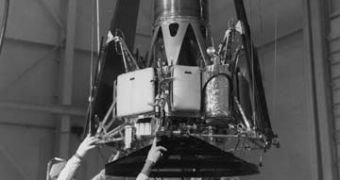On April 23, 1962, 20:50:00 UTC Ranger 4 lifts off into space with the help of an Atlas-Agena B rocket, for a three day journey to the Moon. Ranger 4 was amongst one of the first US missions sent to the Moon to study its surface. It was part of the Ranger program, involving other eight such spacecrafts built by NASA' Jet Propulsion Laboratory in Pasadena.
Ranger 4 carried on board four instruments including a vidicon television camera, a gamma-ray spectrometer, a radar altimeter and a seismometer which was allegedly supposed to land on the lunar surface at a speed between 130 and 160 kilometers per hour in order to study whether the Moon experiences any seismic activity or not.
Other six cameras, five wide-angle cameras and a narrow angle one were carried by the Ranger 4 spacecraft. Two of them were F-channel, while the other four were P-channel cameras. The last image captured by one of the F-channel was taken between 2.5 and 5 seconds before the impact with the lunar surface, at an altitude of about 5 kilometers, while the P-channel cameras were able to surprise images between 0.2 and 0.4 seconds before the catastrophic impact, at an altitude of 600 meters above ground.
Upon reaching the Moon's orbit, the Ranger 4 was supposed to launch a small capsule and fire its retrorockets in order to decrease the landing speed. However, a failure in the spacecraft's central computer and sequencer caused the extension of the solar panels and the operation acquisition systems to cease activity, sending the spacecraft towards the far side of the Moon at speeds up to 9,600 kilometers per hour. Apparently, the only system still operational after the incident was the battery powered transmitter in the small capsule.
It was the second spacecraft ever sent to another cosmic body, after the Ranger 3. Although the Ranger 4 failed in completing its primary mission, it and others alike helped in the landing of the first manned mission on the Moon during Apollo 11. Ranger 7, 8 and 9, for example, relayed high-resolution images with the potential landing sites for Apollo 11. Ranger 8, in fact, crashed in the Mare Tranquillitatis, the site were Apollo 11 would land only four years later.

 14 DAY TRIAL //
14 DAY TRIAL //